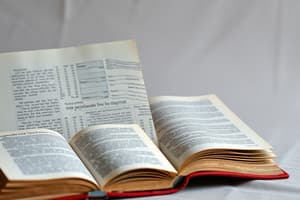Podcast
Questions and Answers
In the 'Unscramble Me!' game, what happens after the allotted time for guessing a word?
In the 'Unscramble Me!' game, what happens after the allotted time for guessing a word?
- The next word is automatically revealed.
- Players show their answers. (correct)
- The game ends.
- Players discuss answers with each other.
What is the primary objective of the 'Unscramble Me' game?
What is the primary objective of the 'Unscramble Me' game?
- To guess the words/phrases. (correct)
- To enhance communication skills.
- To improve memory skills.
- To learn new languages.
Which type of source typically offers reflection or analysis on an original product?
Which type of source typically offers reflection or analysis on an original product?
- Primary Source
- Index
- Tertiary Source
- Secondary Source (correct)
Which of the following is an example of oral tradition?
Which of the following is an example of oral tradition?
Which type of source would an encyclopedia be classified as?
Which type of source would an encyclopedia be classified as?
What does the term 'indigenous knowledge' refer to?
What does the term 'indigenous knowledge' refer to?
Which of the following evaluates if information applies to the research question?
Which of the following evaluates if information applies to the research question?
Which source is most likely to contain traditional wisdom?
Which source is most likely to contain traditional wisdom?
What aspect of information evaluation considers the author's qualifications?
What aspect of information evaluation considers the author's qualifications?
What characteristic is associated with indigenous knowledge?
What characteristic is associated with indigenous knowledge?
Which information evaluation method asks, 'When was this information published or last updated?'
Which information evaluation method asks, 'When was this information published or last updated?'
Which of the following is classified as a source of information?
Which of the following is classified as a source of information?
What does 'appropriateness' mean when evaluating information?
What does 'appropriateness' mean when evaluating information?
What is the primary purpose of production in indigenous knowledge systems?
What is the primary purpose of production in indigenous knowledge systems?
Besides folk knowledge, which term also describes Indigenous knowledge?
Besides folk knowledge, which term also describes Indigenous knowledge?
Which information evaluation is related to the depth of coverage adequate?
Which information evaluation is related to the depth of coverage adequate?
What characterizes the indigenous approach to resource use?
What characterizes the indigenous approach to resource use?
What is the role of nature in indigenous knowledge systems?
What is the role of nature in indigenous knowledge systems?
If information is written to persuade someone, what aspect of information evaluation is involved?
If information is written to persuade someone, what aspect of information evaluation is involved?
How does indigenous knowledge adapt to new situations?
How does indigenous knowledge adapt to new situations?
What best describes the social structure within indigenous knowledge systems?
What best describes the social structure within indigenous knowledge systems?
What is a library?
What is a library?
Which of the following is a user service provided by libraries?
Which of the following is a user service provided by libraries?
Which type of library primarily serves college and university students?
Which type of library primarily serves college and university students?
Which of the following is considered a primary source of information?
Which of the following is considered a primary source of information?
What is the main characteristic of primary sources?
What is the main characteristic of primary sources?
Which of these is an example of an artifact related to a certain period?
Which of these is an example of an artifact related to a certain period?
What does a patent primarily grant to an inventor?
What does a patent primarily grant to an inventor?
What purpose does a diary serve as a primary source?
What purpose does a diary serve as a primary source?
Which of these is an example of a primary source in the form of a recording?
Which of these is an example of a primary source in the form of a recording?
Which of the following is considered a primary source?
Which of the following is considered a primary source?
Which option represents a type of primary source?
Which option represents a type of primary source?
Flashcards
Internet
Internet
A global computer network for information and communication.
Primary Sources
Primary Sources
Original materials from a specific period, not filtered or modified.
Artifacts
Artifacts
Objects made or created by humans, such as tools or artworks.
Patent
Patent
Signup and view all the flashcards
Diary
Diary
Signup and view all the flashcards
Audio/Video Recordings
Audio/Video Recordings
Signup and view all the flashcards
Other Primary Sources
Other Primary Sources
Signup and view all the flashcards
Oral Tradition
Oral Tradition
Signup and view all the flashcards
Legends
Legends
Signup and view all the flashcards
Culture
Culture
Signup and view all the flashcards
Library
Library
Signup and view all the flashcards
Survey
Survey
Signup and view all the flashcards
Summary
Summary
Signup and view all the flashcards
Indigenous Knowledge: Production
Indigenous Knowledge: Production
Signup and view all the flashcards
Indigenous Knowledge
Indigenous Knowledge
Signup and view all the flashcards
Diversified Production Systems
Diversified Production Systems
Signup and view all the flashcards
Locally Appropriate Knowledge
Locally Appropriate Knowledge
Signup and view all the flashcards
Respect for Nature
Respect for Nature
Signup and view all the flashcards
Human-Nature Dependence
Human-Nature Dependence
Signup and view all the flashcards
Indigenous Knowledge: Flexibility
Indigenous Knowledge: Flexibility
Signup and view all the flashcards
Social Responsibility (Indigenous)
Social Responsibility (Indigenous)
Signup and view all the flashcards
Types of Libraries
Types of Libraries
Signup and view all the flashcards
Indexes
Indexes
Signup and view all the flashcards
Secondary Sources
Secondary Sources
Signup and view all the flashcards
Tertiary Sources
Tertiary Sources
Signup and view all the flashcards
Relevancy
Relevancy
Signup and view all the flashcards
Appropriateness
Appropriateness
Signup and view all the flashcards
Currency
Currency
Signup and view all the flashcards
Authority
Authority
Signup and view all the flashcards
Study Notes
- The presentation focuses on media and information sources
- The objectives are to distinguish different sources of information, realize the value of each source, and evaluate information from each source.
- The guiding question is: How did legends, myths, folk tales, epics, and folk songs come into writing?
Classification of Information Sources
- Indigenous Knowledge
- Libraries
- Internet
Indigenous Knowledge
- This is a distinctive knowledge kept to a specific group of people.
- Local knowledge, folk knowledge, people’s knowledge, traditional wisdom, or traditional science are other terms used for it.
- Its topographies include:
- Local appropriateness - a way of life advanced to local conditions.
- Restraint in resource exploitation - production is for survival needs only and what is taken from the environment should only be what is necessary for immediate survival.
- Diversified production systems - there is no abuse of resources and various strategies are used to avoid risks.
- Respect for nature - Treating the land as sacred and having a conservation ethic,
- Humans are dependent on nature for survival and all species are interrelated.
- Indigenous knowledge adapts to new circumstances and is open to outside knowledge.
- There are strong family and community ties and feelings of obligation and responsibility to preserve the land for future generations,
Libraries
- A library is a building, room, or organization that has a collection, especially of books, music, and information.
- Information in a library can be accessed by computer for people to read, use, or borrow.
- Types of services provided include:
- User services - link people to the information they seek.
- Technical services - gather, catalog, and prepare library materials.
- Computer services - maintain databases, software programming, and web page design.
- Administrative services - manage the library, convey contracts, supervise employees and prepare budgets.
- Types of libraries:
- Academic Libraries - Attend colleges and Universities
- Public Libraries - Attend to cities and towns of all types
- School Libraries - Attend to students from Kindergarten - Grade 12
- Special Libraries - Located in specific environments(ie hospitals, corporations, museums, military, private business)
Internet
- This is a global computer network providing a variety of information and communication facilities.
- It consists of interconnected networks using standardized communication protocols.
Other Classification of Information Sources
- Primary Sources encompass materials from a certain period which have not been filtered or modified through analysis or interpretation.
- Examples of primary sources:
- Artifacts - Things made or created by humans (tools, works of art, archaeological objects)
- Patents - granting of right to invention by a sovereign authority
- Diaries - records with distinct entries organized by date reporting on daily activities or other periods.
- Audio/video recordings. In addition, emails, interviews, journal articles, letters, minutes of meetings, conferences and symposia, newspaper articles, original documents (birth certificates, marriage certificates), photographs, and records of organizations, research survey results, speeches, works of art, literature, architecture, music and websites
Secondary Sources
- These are written after an original product and aim to give reflection or analysis.
- Indexes are typically in one or more individual volumes near the end of a set. E.g. index, bibliography, indexing periodicals, and abstracting periodicals.
- Survey type involves examination or description. E.g. reviews, treatises, and monographs.
- Reference type encompasses materials collected using other's works.
- Examples: encyclopedia, dictionary, handbook, manual and critical tables.
Tertiary Sources
- Involve information which collects and organizes primary and secondary sources.
- Bibliography of bibliographies, directories and yearbooks.
- Guides to literature.
- Lists of research in progress.
Ways to Evaluate Information
- Relevancy - Is the information relevant to the question?
- Appropriateness - Is the information suitable to my age and core values?
- Detail - Is the depth of coverage adequate?
- Currency - When was the information last updated?
- Authority - Who is the author of the information and what are their qualifications?
- Bias - Was it written to inform, persuade, entertain, or sell?
Studying That Suits You
Use AI to generate personalized quizzes and flashcards to suit your learning preferences.




